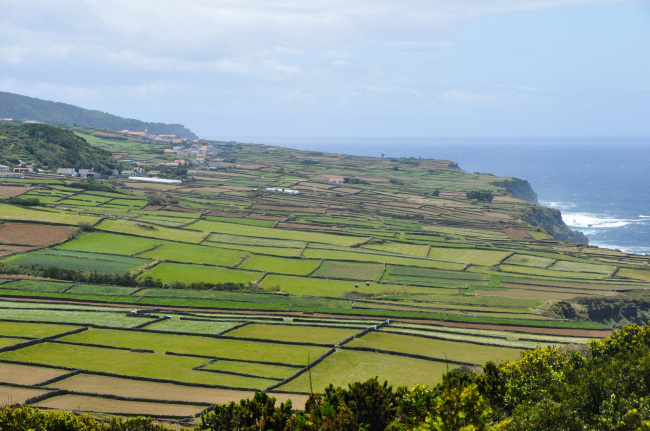VILA NOVA, TERCEIRA, Azores -- There are ways to look nonchalant when you stand on a street with nothing between you and an over 900-kilogram bull but a few skinny guys with a rope.
Strike a vigorous stance with hands on your hips, for one. That projects machismo. Hands in your pockets can make you look fairly unruffled, too. Talking loudly and unconcernedly with friends shows you’re fine with a little danger.
Crossing your arms, however, isn’t recommended. That might stray just a little into nervous territory.
Regardless of the preliminary posturing, the cool and collected looks invariably vanish this evening in an instant. For the men -- and it’s all men, not a woman on the street to be seen -- taking part in this Terceira village’s traditional touradas a corda, translated literally as “bull on a rope,” everything changes when the bull executes a 180-degree turn at the far end of the street and comes barreling at them.
Strike a vigorous stance with hands on your hips, for one. That projects machismo. Hands in your pockets can make you look fairly unruffled, too. Talking loudly and unconcernedly with friends shows you’re fine with a little danger.
Crossing your arms, however, isn’t recommended. That might stray just a little into nervous territory.
Regardless of the preliminary posturing, the cool and collected looks invariably vanish this evening in an instant. For the men -- and it’s all men, not a woman on the street to be seen -- taking part in this Terceira village’s traditional touradas a corda, translated literally as “bull on a rope,” everything changes when the bull executes a 180-degree turn at the far end of the street and comes barreling at them.

Instant scattering, as fast as cockroaches under a switched-on light. Men leaping over temporary barricades set up along the side of the street that protect the saner people of the village. A raised stage area next to the street becomes a refuge, with strong hands helping stragglers up to safety.
And some of the men simply running (and screaming) as fast as they can.
It’s my first visit to Terceira and my first time at a touradas a corda. I feel sorry for the teased and antagonized bull, although he isn’t hurt -- and will receive great acclaim and a long life if he is “brave” -- but I am fascinated by the event. It’s a microcosm of an island culture that holds on proudly to its traditions and yet is very much a part of the 21st century.
I feel that way for much of my weeklong stay earlier this summer on the island, absorbing the rhythms of a place steeped in history but much influenced by the large number of expatriates -- many from the San Joaquin Valley -- who return in a flood each summer. Plus, there’s just general “progress” to contend with. The world is a much smaller and more connected place than decades ago when people from the Azores emigrated en masse to such places as Manteca, Tulare and Fresno, California, and Providence, Rhode Island.

Villages hold the bull events throughout the season, from May to October, as part of individual festivals. Terceira is the only island on which they occur, a point of pride.
The blend of the old and new at the event is striking.
For one thing, this doesn’t look like a period movie. Except for the pastores, or rope holders, who are dressed in an official looking uniform of gray pants, baggy white tunic and proper black-rimmed hat, the dress code of the evening is distinctly casual: jeans, shorts, T-shirts. (I’d be wearing padded clothing if I were out there.) Azoreans from centuries past would scratch their heads in amazement.
And, frankly, Vila Nova (translated as New Town) isn’t the most picturesque or authentic-looking village on Terceira in which to watch the bulls run. It looks, well, new. Not quite the charm of the villages of Biscoitos, Altares and Serreta up the coast. (But this is where the bulls are tonight.)
Perhaps the most striking thing is how much American English I hear around me along with the distinctly accented Azorean Portuguese.
One young American man in jeans and a tight long-sleeved jersey shirt makes a show of doing the “Running Man dance” and shouting for his friend to capture him on cellphone video. His goal is obvious: to do the dance with the bull behind him.
That strategy comes to a crashing halt, however, when the animal charges up the street. The dance part is dropped as the running man leaps up on the stage for safety.
We are on Terceira to visit a journalist friend who is spending the summer watching her beautiful white Labrador retriever turn green from diving into cow water.

Diana Marcum, a Pulitzer Prize-winning reporter for the Los Angeles Times, is on book leave -- under contract with Amazon’s new publishing arm, Little A, with her book set for a spring 2017 release -- for a year writing about the Azores, one of her favorite places in the world.
Her book is titled “The Tenth Island,” a reference to the nine islands of the archipelago plus the extensive diaspora of Azoreans elsewhere in the world, some of whom return each summer.
With Marcum as Azorean-phile host -- and fellow glutton with me each morning for the island’s wonderful fresh bread, probably the most tempting clump of carbohydrates I’ve ever tasted -- I get a feel for Terceira through a newly baptized acolyte’s eyes.
I see the island as she does: the spectacular rocky vistas; the quaint villages; the fresh swordfish and octopus; the patchwork patterns of fields separated by stone walls. I marvel at the volcanic pools next to crashing surf where Murphy -- the beloved dog whom she drove all the way across the United States so she could fly him to Terceira from Boston -- rollicks and romps with snorts of canine joy.
We visit the beautiful major city, Angra de Heroismo, a UNESCO heritage site, on the southern coast, with its 16th-century buildings and charming streets paved with white limestone and black basalt. We eat more fish. We explore the center of the island and visit the Algar do Carvao, an ancient lava tube studded with stalactites and with a lake at the bottom, and the Gruto do Natal, a volcanic cave where you pay your admission fee, are handed a hard hat and walk-slash-crawl through a subterranean adventure.
Did I mention the fish?
Most of all, thanks to Marcum, we meet some of the wonderful people of Terceira. They are used to an influx of visitors. When I say I’m from California, I am asked several times: “Oh! Have you ever been to Turlock?” (Not San Francisco, Los Angeles or San Diego.)
And they are friendly, hospitable and keenly proud of their island. When people find out we first visited Sao Miguel, the most populated island, before coming to Terceira, the inevitable response is: We are much better, prettier, happier, etc.
Indeed, with a summer crammed with festivals and late celebratory nights, Terceira considers itself in a league of its own.
“The saying goes that there are eight islands and the party that is Terceira,” Marcum says.
Back at the touradas a corda, I’m standing behind a 1.5-meter high barricade in front of the steps of the village’s Imperio do Divino Espirito Santo, a small structure where the activities of the Cult of the Holy Spirit take place. The first bull session is over and most of the town is in the street: drinking beer, exchanging small talk, flirting.
Years ago, this intermission was a key time for men and women to court each other, says Elmano Costa, a Cal State Stanislaus professor who befriends me. He has a family home in Terceira. Girls and boys were separated in school when he was growing up on the island. It wasn’t easy to find a chance for the sexes to mix.
I watch a man approach a line of six or so women positioned above. He tries to gab. They pointedly ignore him.
A warning bang goes off: The next bull is going to be let loose soon. The crowd in the street dissipates, leaving the “brave” men to linger.
Not all of them run when the bull comes close. There are the capinas.
“They are not professionals,” Costa says. “They are amateurs. They do it for the love of bullfighting. They basically risk their lives.”
Using red capes or umbrellas, the men take turns getting as close to the bull as they can.
Yes, people do get hurt -- and killed. Elmano recently learned that if you get injured in a bullfight, the national health plan will not cover you, he says.
Just this year, he says, a man from his village was hit in the head when the bull got too close and the crowd surged. He’s never recovered.
Marcum adds that, anecdotally speaking, American-Azorean immigrants sometimes get hurt.
By Donald Munro
The Fresno Bee
(Tribune Content Agency)
-
Articles by Korea Herald








![[Hello India] Hyundai Motor vows to boost 'clean mobility' in India](http://res.heraldm.com/phpwas/restmb_idxmake.php?idx=644&simg=/content/image/2024/04/25/20240425050672_0.jpg&u=)











